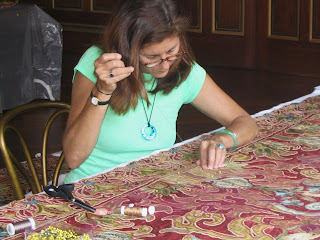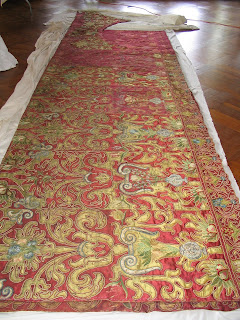by Therese Veier, ARCA Blog Norwegian Correspondent
Geir Ove Kvalheim has been indicted by Økokrim, Norway’s art crime unit, accused of committing extensive forgeries of writings and documents from the world famous authors Knut Hamsun and Henrik Ibsen. One of the buyers of Kvalheim's alleged forgeries is The National Library in Norway[1]. The library bought the supposed fakes via Norli’s antique shop[2] in Oslo.
When the news about the scale of the forgeries and the indictment broke, Kvalheim found himself in the middle of a scandal that has really upset Norwegian collectors and the National Library as well as experts and scholars on Hamsun and Ibsen[3].
After an ongoing police investigation since 2008, Økokrim has now indicted the 41-year-old man with gross fraud in connection with the resale of a number of writings and documents that allegedly originated from Knut Hamsun and Henrik Ibsen[4]. The indictment includes 13 documents, amongst others [5]:
-manuscript fragments of the novel På Gjengrodde stier / On Overgrown Paths by Knut Hamsun;
-manuscript fragments of the novel John Gabriel Borkman by Knut Hamsun;
-registration letter for the NS (6) signed by Knut Hamsun;
-pocket almanac from 1943 with Knut Hamsun’s own handwritten notes;
-handwritten obituary by Knut Hamsun for Vidkun Quislings death[7];
-two first editions by Henrik Ibsen’s novel John Gabriel Borkman with dedications to Bjørnstjerne Bjørnson and Edvard Munch;
-a letter from Henrik Ibsen to Knut Hamsun dated 1891, inscription by Knut Hamsun dated 1948; and
-other letters and personal greetings
Constructed ownership
- This is a unique criminal case in both Norwegian and European context. We are very familiar with art forgery, but in this country we have never seen attempted fraud with historical documents in this way or to this extent before, says chief public prosecutor Hans Tore Høviskeland in Økokrim’s environmental crime department. [8]
This type of fraud is really grave, but sadly I do not think it is unique, it may be unique in Norway but not in European fraud history. Fraud cases involving forgery of provenance and documents can be very tricky and hard to detect, but after the well known British case involving John Myatt and John Drewe perhaps people are becoming more aware.
During Økokrim’s investigations to reveal Kvalheim’s forgeries they used font experts and performed provenance research. According to the indictment, information about previous ownership in several cases was constructed by Kvalheim without the knowledge of the various people listed as previous owners. [9]
It sounds as if this was a rather poorly constructed fake provenance that should have been easy to detect when Kvalheim first approached the antiques dealers.
Lars Frode Larsen, a Hamsun researcher, was among those who already early on raised the alarm about possible fakes of Hamsun related documents from Kvalheim’s collection.
-The police investigation has taken more than three years, but I am glad charges have now been brought, says Larsen. [10]
Had a commission agreement
According to Økokrim’s indictment most of the sales where made in the years 2005-2006, through a commission agreement Kvalheim made with Norli’s antique shop in Oslo. Via Norli’s antique shop, several of the fake documents made their way into the National Library’s collection, who during this period bought eight fake Hamsun documents for the total amount of 695 000 NOK (92 000 Euro). [11]
In March 2006, Kvalheim also offered Cappelen's antiquarian bookshop in Oslo the chance to buy a supposedly unknown play by Henrik Ibsen entitled The Sun God. However the bookshop employees expressed doubts about the object's authenticity and did not take it on commission to resell any of these items. However, now, Kvalheim is also charged for this attempt of fraud.
In addition to these crimes, Kvalheim is accused of having sold a fake award evidence, the object is a gold German Cross from the Waffen SS. This was sold to the shop Derek’s Militaria in Tønsberg for the sum of 20 000 NOK.
Embarrassing to have been duped
The head of Norli’s antiquary, Rolf Warendorf is shocked at the extent of the fraud, but believes this is a one-time event.
- It is embarrassing to have been duped in this way. This is not a good thing for us, says Warendorf. [12]
It was Warendorf who first met with Kvalheim in 2005. He considered the items to be authentic, and agreed to take them in commission.
Probably more fakes in the market
Both Økokrim’s investigators and Hamsun expert Lars Frode Larsen warns collectors that there may be more fakes in the market.
- We have seen that there have been other fakes in circulation than those covered by the indictment, said Høviskeland in Økokrim. [13]
-I encourage people who have purchased items that can be linked to Kvalheim, to perform a thorough check of previous ownership history on the objects purchased, advises Larsen.[14]
On Tuesday 29th of November Warendorf from Norli’s antigue shop could still not say exactly how much material the bookshop had purchased from the collector, except that it is “much more” than those contained in Økokrim’s indictment.[15]
I find some of Warendorf’s statements very alarming, particularly when he says the bookshop has not done anything with their procedures to prevent such scandals in the future. Unfortunately this illustrates the naivety and lack of knowledge about these types of crimes among some of the professionals which in turn makes it easier for conmen to slip fakes into the market.
- I am convinced this is an exceptional case. This is not something that happens every ten or fifty years, says Warendorf.[16]
The National Library has yet not made a public comment about the indictment. The defendant (Kvalheim), and his lawyer, have so far refused to make any comments.
I will continue to follow this case closely. It seems like Økokrim has made a thorough investigation. It sends an important signal that this type of fraud is treated as especially grave, because forging these type of objects can contribute to create a false impression of important people, events and works that are a part of Norwegian cultural and literary history. On the other hand it is naïve and scary that some professional dealers think this type of crime is almost non-existent, and that they seem unwilling to revise their routines for provenance research. It is much harder to reveal forgeries once they are resold and have entered the market or collections, private or public. So in the meantime, it is perhaps best for collectors to follow the old Latin saying “caveat emptor” (Let the buyer beware).
About Geir Ove Kvalheim:
Kvalheim is a Norwegian actor, director and copywriter, as well as being a collector. Kvalheim has been involved in an earlier judicial dispute. In 2009 he was convicted and had to pay Fredrik Jensen, an SS-veteran, the amount of 370 000 NOK (49 000 Euro), after an allegation concerning fraud in connection with a planned documentary film about Norwegian SS-veterans.[17]
In 2001 Jensen also gave the director a loan of 200 000 NOK for production of the documentary; however, the documentary was never finalised.
Text by Therese Veier, an art historian, lawyer and writer. Currently works at Public Art Norway.
Sources:
 Amelia,collection inventories,museo archeologico
Amelia,collection inventories,museo archeologico
 No comments
No comments
 Amelia,collection inventories,museo archeologico
Amelia,collection inventories,museo archeologico
 No comments
No comments

















